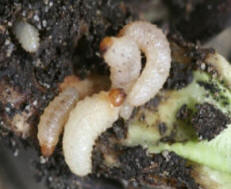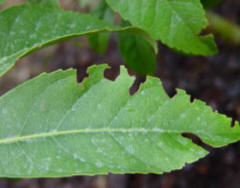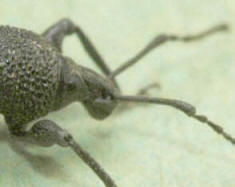The Vine Weevil Beetle is now a major pest for certain crops and plants in the UK and Europe.
Whilst the adult beetle doe little more than disfigure the leaves that it feeds upon, the young, by the way of small grubs, eat into the root system of a wide range of plants.
There are two problems with control. The first being that the Vine Weevil Beetle is not much more than approximately 1cm long from end of feeler to rear end - and is mainly nocturnal!
The second problem is that the larvae of the beetle can chomp away unseen below ground, until it is too late to save the attacked plant!

The first sign of problems - often unnoticed and unheeded - will be the damage caused to plant foliage by the adult vine weevil beetle. (As seen in the image below). thereafter, plant will be found wilting, or simply falling over once their root system has been eaten away by the Vine Weevil Beetle's maggots!


The right hand image shows the 'business end of the Vine weevil, with
its narrow jaw structure which cuts the 'slices' out of leaves.
Strangely, it is not normally the plant that that has been fed upon that
suffers the most damage. It is often plants some distance away - and
totally unrelated to the damaged foliage plant - that often get attacked
by the larvae.

Control
The only effective 'spray' that we have been happy with is Provado Vine Weevil Killer 2 (Bayer) which contains Thiacloprid - which seems to be the only effective chemical at time of writing (Dec 2010). This is normally applied as a drench to the soil. It is probably effective for up to 4 months for a single treatment, so further treatments may be necessary in areas where Vine Weevil Beetle are a severe problem.
There is normally just one generation each year - thankfully - and the larvae overwinter below soil level - having a feast at the same time, so Spring is often the first sign of trouble, as some prized plants either do not come into growth, or simply look very limp - as a result of having their root system attacked
Hunting the adult beetle by night, and torchlight is also effective! (Do warn your neighbours and local Neighbourhood Watch committee!). A dry evening is best, for then any offending adult beetles will show up better against the light coloured soil. Simply shake the shrubs - particularly those that seem to be the feeding area - and the beetles will fall to the ground. How you dispose of them is a matter of choice. They never seem to recover from being trodden into the ground!
It is almost impossible to have any great affect when hunting down and dealing with the vine weevil beetle in your garden plot. Simply look for the tell-tale signs of plants suddenly heeling over - with the 'cut-off' damage just slightly below ground level.
Control of the Vine Weevil beetle larvae is much more effective and easy in container grown plants.
Also, lift container plants to see if the Vine Weevil Beetles are hiding underneath - this is particularly good practice in the greenhouse.
Biological controls are available for those who do not wish to use chemicals. The most effective being the nematode Heterorhabditis megidis. Don't worry about remembering the name. It will be found at most good garden centres as Vine Weevil Killer - under Biological control. Be aware that you only buy a pretty box at Garden Centres! The box will contain a ticket/voucher, which you then send off to the lab to get your supply of the nematodes.
Plants Affected
Most alpine and rockery plants - Primulas in
particular - also violas/pansies.
Fuchsias
Most Container Plants
Rhododendrons
Euonymus
I have recently discovered a mature containerised Liriodendron (Tulip
Tree) to have been attacked.
Ignore the signs of Vine Weevil Beetle at your own peril!
Main Page for Apple Tree Problems